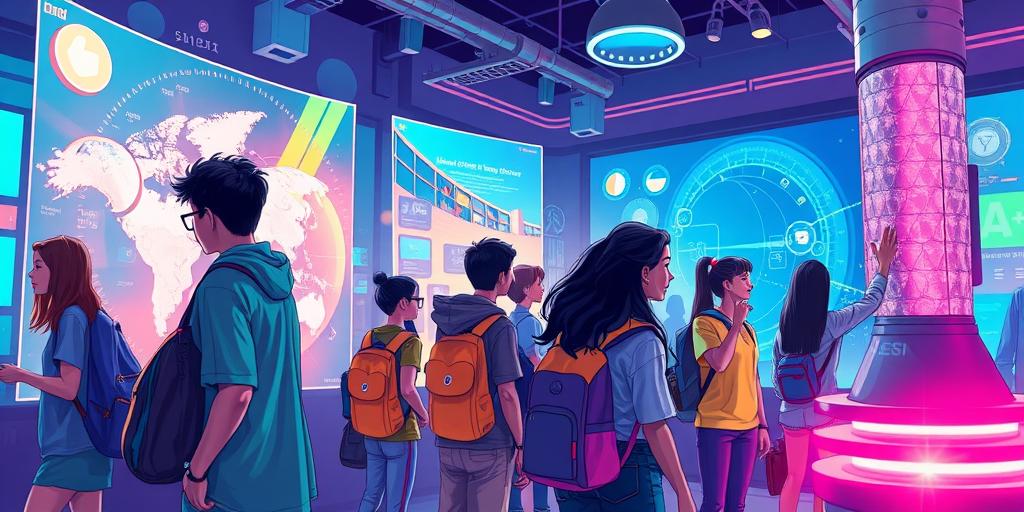Prepare to have your mind blown! The world of education is undergoing a revolution, and it’s not your grandfather’s chalkboard anymore. Augmented reality (AR) and virtual reality (VR) gadgets are transforming how we learn, making education more engaging, immersive, and effective than ever before. Forget rote memorization – get ready for interactive experiences that stick with you. This isn’t just about fancy tech; it’s about unlocking a new era of learning potential for students of all ages.
Immersive Learning Experiences: Stepping into the Textbook
Imagine dissecting a frog without the smell or the mess! Or exploring the Amazon rainforest without leaving your classroom. That’s the power of AR and VR in education. These technologies create immersive, interactive learning environments where students can experience concepts firsthand, rather than just reading about them in a textbook.
Interactive Simulations:
Virtual reality offers unparalleled opportunities for interactive simulations. Students can practice complex procedures in a safe, controlled environment, such as performing surgery, conducting experiments, or even managing a business. These simulations provide invaluable hands-on experience that enhances comprehension and boosts confidence.
360° Field Trips:
Augmented reality allows students to take virtual field trips to locations around the globe, all from within the classroom. Imagine visiting the pyramids of Egypt or exploring the Great Barrier Reef, all without the cost and logistical challenges of traditional field trips. AR and VR can help students connect with the subject matter in meaningful ways, bridging the gap between theory and practice.
Gamification of Learning:
Let’s face it, learning can be tough. But what if we could make it fun? AR and VR technologies can gamify learning experiences, transforming traditionally dry subjects into captivating adventures. Through interactive games and challenges, students can develop their critical thinking and problem-solving skills while having a blast. It’s education disguised as entertainment!
Accessibility and Personalized Learning: Reaching Every Student
One of the most transformative aspects of AR and VR in education is their potential to address the needs of diverse learners. These technologies offer personalized learning experiences that cater to different learning styles and paces.
Catering to diverse learning styles:
Unlike traditional methods that often cater to visual learners, AR and VR offer multiple modalities of learning. Students can engage with information through visual, auditory, and kinesthetic experiences, helping learners of all kinds thrive.
Personalized learning paths:
AR and VR can adapt to individual student needs, creating personalized learning paths that cater to their strengths and weaknesses. Students can progress at their own pace, revisiting concepts as needed, and focusing on areas where they need extra support.
Breaking down geographical barriers:
AR and VR can make high-quality education accessible to students in remote or underserved areas. These technologies can deliver engaging and effective educational content to learners who might not have access to traditional educational resources. This is particularly important for creating educational equity.
The Future of AR/VR in Education: A New Horizon
The integration of AR and VR technologies in education is still in its early stages, but the potential is staggering. As the technology continues to evolve, we can expect even more innovative applications to emerge.
Enhanced collaboration tools:
AR and VR can foster collaboration among students, allowing them to work together on projects and share ideas in virtual environments. This enhances teamwork and communication skills.
Advanced simulation and modeling:
Future AR and VR applications will allow students to create and manipulate complex models, fostering creative and critical thinking skills. Imagine building virtual cities or designing innovative technological solutions within a virtual sandbox!
Integration with other educational technologies:
AR and VR will become increasingly integrated with other educational technologies, such as learning management systems (LMS) and adaptive learning platforms. This will create more holistic and effective learning experiences.
Call to Action: Embrace the Future of Learning!
The transformative power of AR and VR in education is undeniable. It’s time to embrace this technological leap and equip our students with the 21st-century skills they need to thrive. Are you ready to join the revolution and make learning more engaging, inclusive, and effective? Let’s shape the future of education together!




